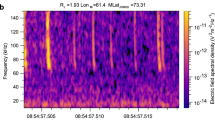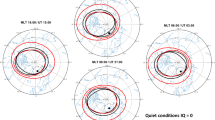Abstract
WHEN considering ionospheric sunrise effects one must remember that the light of sunrise at a specific ionospheric height has been filtered through the entire atmosphere before reaching a point of ground sunrise; also the light has had the filtering action of the air between the point of ground sunrise and the westward point at that ionospheric altitude. Thus the ionization power of solar radiation at high altitudes is reduced to mere heat effects during the time before ground sunrise. In this respect, vibrational excitation1 may have to be considered, but specifically at lower altitudes. Furthermore, existing drifts in the ionosphere, such as winds and waves in the neutral gas as well as electron and ion fluxes, have some influence. A downward electron flux is typical for a period after midnight or before dawn2. During winter, an arrival of electrons from the conjugate ionosphere (which is in summer and has an earlier sunrise) may play a part by increasing the pre-sunrise ion and electron temperatures especially at European mid-latitudes3. Finally, the diurnal cycle of the ionospheric motions, that is the downward move of the F-region maximum from an altitude of 400 km before sunrise to an altitude of 250 km after sunrise, has to be considered (H. F. Bates in a paper read to the US URSI spring meeting in 1968). Together, these effects are likely to produce a turbulent motion within the ionosphere at a specific point of first illumination.
This is a preview of subscription content, access via your institution
Access options
Subscribe to this journal
Receive 51 print issues and online access
$199.00 per year
only $3.90 per issue
Buy this article
- Purchase on Springer Link
- Instant access to full article PDF
Prices may be subject to local taxes which are calculated during checkout
Similar content being viewed by others
References
Thomas, L., and Norton, R. B. J. Geophys. Res., 71, 227 (1966).
Arendt, P. R., and Soicher, H., Nature, 204, 983 (1964).
Evans, J. V., J. Geophys. Res., 73, 3489 (1968).
Vogt, G., The Radio and Electronic Engineer, 28, 269 (1964).
Arendt, P. R., Fischer, W. H., Grau, J., Soicher, H., and Vogt, G. J. Geophys. Res., 71, 4147 (1966).
Arendt, P. R. Nature, 218, 1149 (1968).
Author information
Authors and Affiliations
Rights and permissions
About this article
Cite this article
ARENDT, P., SOICHER, H. Onset of Severe Amplitude Scintillations of Satellite Radio Signals during Sunrise. Nature 220, 459–461 (1968). https://doi.org/10.1038/220459a0
Received:
Issue Date:
DOI: https://doi.org/10.1038/220459a0
This article is cited by
Comments
By submitting a comment you agree to abide by our Terms and Community Guidelines. If you find something abusive or that does not comply with our terms or guidelines please flag it as inappropriate.



